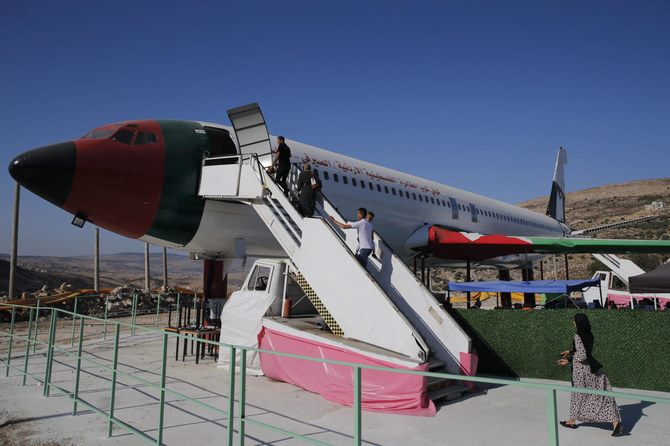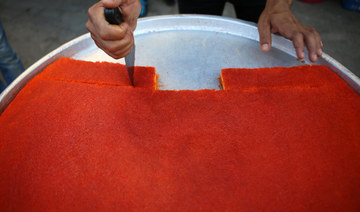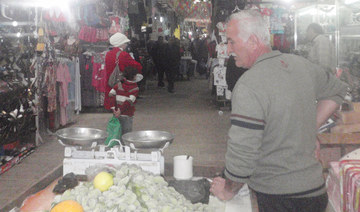RAMALLAH, West Bank: Few Palestinians in the occupied West Bank get to board an airplane these days. The territory has no civilian airport and those who can afford a plane ticket must catch their flights in neighboring Jordan. But just outside the northern city of Nablus, a pair of twins is offering people the next best thing.
Khamis al-Sairafi and brother Ata have converted an old Boeing 707 into a cafe and restaurant for customers to board.
‘‘Ninety-nine percent of Palestinians have never used an airplane. Only our ambassadors, diplomats, ministers and mayors use them. Now they see an airplane and it is something for them,’' said Khamis al-Sairafi.
After a quarter century of effort, the brothers opened “The Palestinian-Jordanian Airline Restaurant and Coffee Shop al-Sairafi” on July 21.
Families, friends and couples turned up for drinks in the cafe situated below the body of the plane. Many others came to take photos inside at a price of five shekels (about $1.50) per person.
Customers said they were motivated to visit after seeing pictures of the renovated plane circulating online. ‘‘For a long time, I have wanted to see this place. I wish I had seen this place before it was turned into a café,’’ said customer Majdi Khalid.
For years, the jetliner sat along the side of a major highway in the northern West Bank, providing endless fodder for conversation for passersby baffled by its hulking presence.
The 60-year-old identically dressed twins' dream of transforming the airplane into a cafe and restaurant was born in the late 1990s when Khamis saw the derelict Boeing aircraft near the northern Israeli city of Safed.
At the time, the plane already had an illustrious history. The aircraft was used by the Israeli government from 1961 to 1993 and flew then-Prime Minister Menachem Begin to the United States in 1978 to sign Israel's historic peace agreement with Egypt, according to Channel 12 TV.
It was later bought by three Israeli business partners who dreamed of turning it into a restaurant, but the project was abandoned following disagreements with local authorities, the station said.
After tracking down one of the owners, the brothers agreed to buy it for $100,000 in 1999. They spent an additional $50,000 for licenses, permits and to transport it to the West Bank.
Khamis said the then-mayor of Nablus, Ghassan Shakaa, quickly approved the transportation and renovation of the airplane.
Moving the plane to Nablus was a 13-hour operation, requiring the wings to be dismantled and the temporary closure of roads in Israel and the West Bank. At the time, Israel and the Palestinians were engaged in peace talks and movement back and forth was relatively easy.
The al-Sairafi brothers were successful traders and scrap metal merchants. They regularly traveled to and from Israel buying pieces of metal that they then sold and smelted in the West Bank. They also owned a successful waste disposal business and used their earnings to build an amusement park — including a swimming pool and concert venue — on the same patch of land where the plane was placed.
But they said their project was put on hold after the outbreak of the second Palestinian uprising in late 2000.
An Israeli military checkpoint was built nearby, they said, preventing customers from the nearby city of Nablus from reaching the site. The checkpoint remained for three years and the Israeli military took over the site. The project collapsed.
‘‘They even built tents under the wings of the plane,’’ Ata al-Sairafi said.
The Israeli military did not respond to a request for comment.
For nearly 20 years, the airplane and the site were abandoned. After the uprising faded out in the mid-2000s, the brothers scraped by with their waste disposal business and the small amusement park in Nablus they opened in 2007.
After more than a decade of saving, they decided in 2020 to begin rebuilding what they lost, this time starting with the renovation of the airplane. The coronavirus crisis, which included multiple lockdowns, hit the Palestinian economy hard and caused further delays.
Following months of work, the aircraft is almost ready for full service. The interior is freshly painted, fitted with electricity and nine tables and the doors are connected to two old sets of airstairs allowing customers to board safely. The nose of the plane has been painted with colors of the Palestinian flag and the tail with Jordanian colors.
The cafe is already open and the brothers hope to open the restaurant next month. They plan to install a kitchen below the body of the plane to serve food to customers on board.
However, their long-term goal of re-building the amusement park and swimming pool remains a long way off. The pair said they were disappointed they had not received financial support from the municipality and are looking for investors.
‘‘God willing, I hope the project works and that it becomes the best it can be,’’ said Ata al-Sairafi.
Palestinian twins open cafe in converted jet in West Bank
https://arab.news/23sw7
Palestinian twins open cafe in converted jet in West Bank

- Just outside Nablus, a pair of twins is offering people the next best thing
- Khamis al-Sairafi and brother Ata have converted an old Boeing 707 into a cafe and restaurant for customers to board
A 98-year-old in Ukraine walked miles to safety from Russians, with slippers and a cane

- Describing her journey, the nonagenarian said she had fallen twice and was forced to stop to rest at some points, even sleeping along the way before waking up and continuing her journey
KYIV, Ukraine: A 98-year-old woman in Ukraine who escaped Russian-occupied territory by walking almost 10 kilometers (6 miles) alone, wearing a pair of slippers and supported by a cane has been reunited with her family days after they were separated while fleeing to safety.
Lidia Stepanivna Lomikovska and her family decided to leave the frontline town of Ocheretyne, in the eastern Donetsk region, last week after Russian troops entered it and fighting intensified.
Russians have been advancing in the area, pounding Kyiv’s depleted, ammunition-deprived forces with artillery, drones and bombs.
“I woke up surrounded by shooting all around — so scary,” Lomikovska said in a video interview posted by the National Police of Donetsk region.
In the chaos of the departure, Lomikovska became separated from her son and two daughters-in-law, including one, Olha Lomikovska, injured by shrapnel days earlier. The younger family members took to back routes, but Lydia wanted to stay on the main road.
With a cane in one hand and steadying herself using a splintered piece of wood in the other, the pensioner walked all day without food and water to reach Ukrainian lines.
Describing her journey, the nonagenarian said she had fallen twice and was forced to stop to rest at some points, even sleeping along the way before waking up and continuing her journey.
“Once I lost balance and fell into weeds. I fell asleep … a little, and continued walking. And then, for the second time, again, I fell. But then I got up and thought to myself: “I need to keep walking, bit by bit,’” Lomikovska said.
Pavlo Diachenko, acting spokesman for the National Police of Ukraine in the Donetsk region, said Lomikovska was saved when Ukrainian soldiers spotted her walking along the road in the evening. They handed her over to the “White Angels,” a police group that evacuates citizens living on the front line, who then took her to a shelter for evacuees and contacted her relatives.
“I survived that war,’ she said referring to World War II. “I had to go through this war too, and in the end, I am left with nothing.
“That war wasn’t like this one. I saw that war. Not a single house burned down. But now – everything is on fire,” she said to her rescuer.
In the latest twist to the story, the chief executive of one of Ukraine’s largest banks announced on his Telegram channel Tuesday that the bank would purchase a house for the pensioner.
“Monobank will buy Lydia Stepanivna a house and she will surely live in it until the moment when this abomination disappears from our land,” Oleh Horokhovskyi said.
Amazon Purr-rime: Cat accidentally shipped to online retailer

- Galena was found safe by a warehouse worker at an Amazon center after vanishing from her home in Utah
LOS ANGELES: A curious cat that sneaked into an open box was shipped across the United States to an Amazon warehouse after its unknowing owners sealed it inside.
Carrie Clark’s pet, Galena, vanished from her Utah home on April 10, sparking a furious search that involved plastering “missing” posters around the neighborhood.
But a week later, a vet hundreds of miles (kilometers) away in Los Angeles got in touch to say the cat had been discovered in a box — alongside several pairs of boots — by a warehouse worker at an Amazon center.
“I ran to tell my husband that Galena was found and we broke down upon realizing that she must have jumped into an oversized box that we shipped out the previous Wednesday,” Clark told KSL TV in Salt Lake City.
“The box was a ‘try before you buy,’ and filled with steel-toed work boots.”
Clark and her husband jetted to Los Angeles, where they discovered Amazon employee Brandy Hunter had rescued Galena — a little hungry and thirsty after six days in a cardboard box, but otherwise unharmed.
“I could tell she belonged to someone by the way she was behaving,” said Hunter, according to Amazon.
“I took her home that night and went to the vet the next day to have her checked for a microchip, and the rest is history.”
What did people eat before agriculture? New study offers insight

- Analysis of forms — or isotopes — of elements including carbon, nitrogen, zinc, sulfur and strontium in these remains indicated the type and amount of plants and meat they ate
WASHINGTON: The advent of agriculture roughly 11,500 years ago in the Middle East was a milestone for humankind — a revolution in diet and lifestyle that moved beyond the way hunter-gatherers had existed since Homo sapiens arose more than 300,000 years ago in Africa.
While the scarcity of well-preserved human remains from the period preceding this turning point has made the diet of pre-agricultural people a bit of a mystery, new research is now providing insight into this question. Scientists reconstructed the dietary practices of one such culture from North Africa, surprisingly documenting a heavily plant-based diet.
The researchers examined chemical signatures in bones and teeth from the remains of seven people, as well as various isolated teeth, from about 15,000 years ago found in a cave outside the village of Taforalt in northeastern Morocco. The people were part of what is called the Iberomaurusian culture.
Analysis of forms — or isotopes — of elements including carbon, nitrogen, zinc, sulfur and strontium in these remains indicated the type and amount of plants and meat they ate. Found at the site were remains from different edible wild plants including sweet acorns, pine nuts, pistachio, oats and legumes called pulses. The main prey, based on bones discovered at the cave, was a species called Barbary sheep.
“The prevailing notion has been that hunter-gatherers’ diets were primarily composed of animal proteins. However, the evidence from Taforalt demonstrates that plants constituted a big part of the hunter-gatherers’ menu,” said Zineb Moubtahij, a doctoral student in archaeology at the Max Planck Institute for Evolutionary Anthropology in Germany and lead author of the study published on Monday in the journal Nature Ecology & Evolution.
“It is important as it suggests that possibly several populations in the world already started to include substantial amount of plants in their diet” in the period before agriculture was developed, added archeogeochemist and study co-author Klervia Jaouen of the French research agency CNRS.
The Iberomaurusians were hunter-gatherers who inhabited parts of Morocco and Libya from around 25,000 to 11,000 years ago. Evidence indicates the cave served as a living space and burial site.
These people used the cave for significant portions of each year, suggesting a lifestyle more sedentary than simply roaming the landscape searching for resources, the researchers said. They exploited wild plants that ripened at different seasons of the year, while their dental cavities illustrated a reliance on starchy botanical species.
Edible plants may have been stored by the hunter-gatherers year-round to guard against seasonal shortages of prey and ensure a regular food supply, the researchers said.
These people ate only wild plants, the researchers found. The Iberomaurusians never developed agriculture, which came relatively late to North Africa.
“Interestingly, our findings showed minimal evidence of seafood or freshwater food consumption among these ancient groups. Additionally, it seems that these humans may have introduced wild plants into the diets of their infants at an earlier stage than previously believed,” Moubtahij said.
“Specifically, we focused on the transition from breastfeeding to solid foods in infants. Breast milk has a unique isotopic signature, distinct from the isotopic composition of solid foods typically consumed by adults.”
Two infants were among the seven people whose remains were studied. By comparing the chemical composition of an infant’s tooth, formed during the breastfeeding period, with the composition of bone tissue, which reflects the diet shortly before death, the researchers discerned changes in the baby’s diet over time. The evidence indicated the introduction of solid foods at around the age of 12 months, with babies weaned earlier than expected for a pre-agricultural society.
North Africa is a key region for studying Homo sapiens evolution and dispersal out of Africa.
“Understanding why some hunter-gatherer groups transitioned to agriculture while others did not can provide valuable insights into the drivers of agricultural innovation and the factors that influenced human societies’ decisions to adopt new subsistence strategies,” Moubtahij said.
Palestinian prisoner in Israel wins top fiction prize

- The mask in the novel’s title refers to the blue identity card that Nur, an archaeologist living in a refugee camp in Ramallah, finds in the pocket of an old coat belonging to an Israeli
ABU DHABI: Palestinian writer Basim Khandaqji, jailed 20 years ago in Israel, won a prestigious prize for Arabic fiction on Sunday for his novel “A Mask, the Color of the Sky.”
The award of the 2024 International Prize for Arabic Fiction was announced at a ceremony in Abu Dhabi.
The prize was accepted on Khandaqji’s behalf by Rana Idriss, owner of Dar Al-Adab, the book’s Lebanon-based publisher.
Khandaqji was born in the Israeli-occupied West Bank city of Nablus in 1983, and wrote short stories until his arrest in 2004 at the age of 21.
He was convicted and jailed on charges relating to a deadly bombing in Tel Aviv, and completed his university education from inside jail via the Internet.
The mask in the novel’s title refers to the blue identity card that Nur, an archaeologist living in a refugee camp in Ramallah, finds in the pocket of an old coat belonging to an Israeli.
Khandaqji’s book was chosen from 133 works submitted to the competition.
Nabil Suleiman, who chaired the jury, said the novel “dissects a complex, bitter reality of family fragmentation, displacement, genocide, and racism.”
Since being jailed Khandaqji has written poetry collections including “Rituals of the First Time” and “The Breath of a Nocturnal Poem.”
He has also written three earlier novels.
Mexican doctor claims victory in $28 Cartier earrings battle

MEXICO CITY: A Mexican man has claimed a victory over French luxury brand Cartier, saying an error allowed him to buy two pairs of earrings for $28 that were supposed to cost nearly $28,000.
After a four-month struggle, doctor Rogelio Villarreal said he had finally received the jewelry, which he accused the company of refusing to deliver after his online purchase in December.
According to Villarreal, he came across the low-priced earrings while browsing Instagram.
“I swear I broke out in a cold sweat,” he wrote on the social media platform X.
Cartier declined to recognize the purchase and offered Villarreal a refund, as well as a bottle of champagne and a passport holder as compensation, according to a company letter shared by the doctor.
But Villarreal refused and decided to take the case to Mexico’s consumer protection agency, which ruled in favor of the doctor.
Cartier accepted the decision, Villarreal announced.
“War is over. Cartier is complying,” he wrote.


















